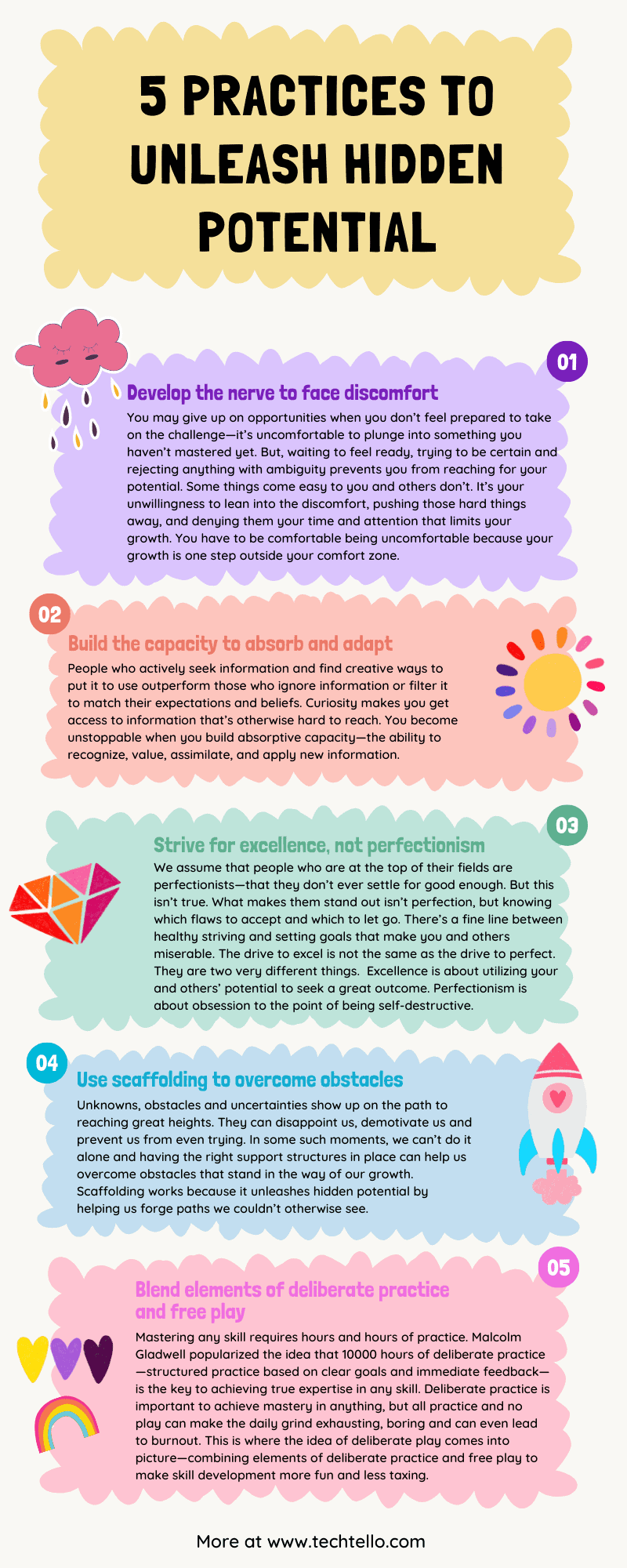How to Unleash Your Hidden Potential
We all have tremendous potential waiting to be unleashed. Some people utilize their potential to achieve amazing feats while others never realize what they’re capable of as they let their self-limiting beliefs get in the way of their growth.
When you consider talent as the only measure of success and don’t give enough credit to effort, attitude and practice, you construct an artificial wall in your mind that limits your visibility and makes you believe you don’t have what it takes to reach the other side.
It’s not your natural ability, but your attitude to learning that determines where you end up. Talent can give you the direction to take, but it can’t keep you on the path. To achieve greater things, you need to break down walls, build the right skills and open new doors to reach the other side.
You can’t tell where people will land from where they begin. With the right opportunity and motivation to learn, anyone can build the skills to achieve greater things. Potential is not a matter of where you start, but of how far you travel. We need to focus less on starting points and more on distance traveled
— Adam Grant, Hidden Potential
With the right techniques, motivation and strategy, you can build an extraordinary path to success and achieve greater things than you ever dreamt to be possible.
Here are the 5 practices that Adam Grant lays out in his book Hidden Potential that can help you reach for your potential and perform at your peak:
Develop the nerve to face discomfort
You may give up on opportunities when you don’t feel prepared to take on the challenge—it’s uncomfortable to plunge into something you haven’t mastered yet.
But waiting to feel ready, trying to be certain and rejecting anything with ambiguity prevents you from reaching for your potential.
How can you explore what you’re capable of if you never take the uncomfortable path?
Becoming a creature of discomfort can unlock hidden potential in many different types of learning. Summoning the nerve to face discomfort is a character skill—an especially important form of determination. It takes three kinds of courage: to abandon your tried-and-true methods, to put yourself in the ring before you feel ready, and to make more mistakes than others make attempts. The best way to accelerate growth is to embrace, seek, and amplify discomfort
— Adam Grant, Hidden Potential
Common ways you may tend to avoid discomfort:
- Doing things the way they’ve always been done instead of embracing novelty.
- Playing safe and avoiding risks.
- Procrastinating by doing easy and fun stuff over things outside your comfort zone.
- Always playing to your strengths while ignoring or avoiding your weaknesses.
- Refusing to practice the skill you need to build because practicing something you haven’t mastered yet is awkward and painful.
Some things come easy to you and others don’t. It’s your unwillingness to lean into the discomfort, pushing those hard things away, and denying them your time and attention that limits your growth.
You have to be comfortable being uncomfortable because your growth is one step outside your comfort zone.
To embrace discomfort:
- Reframe the feeling from anxiety to excitement.
- Equate discomfort with progress.
- Consider mistakes as a sign of learning.
- Stop worrying about being judged.
Stepping outside your comfort zone will become a habit when you consciously seek it in everything you do.
Build the capacity to absorb and adapt
People who actively seek information and find creative ways to put it to use outperform those who ignore information or filter it to match their expectations and beliefs.
Curiosity makes you get access to information that’s otherwise hard to reach. Seeking constructive criticism, focusing on improving instead of proving and challenging your beliefs and assumptions helps you filter out signal from noise.
Adam Grant puts it as “absorptive capacity—the ability to recognize, value, assimilate, and apply new information.”
He explains that building absorptive capacity requires two key habits:
- How you acquire information: Do you react to what enters your field of vision, or are you proactive in seeking new knowledge, skills, and perspectives?
- The goal you’re pursuing when you filter information: Do you focus on feeding your ego or fueling your growth?
To build absorptive capacity:
- Pay attention to the kind of information you seek. Ensure you’re absorbing information that matters.
- Work smarter, not harder. Identify creative ways to achieve goals with less effort.
- Take initiative. Be proactive. Take your learning into your own hands.
- Adapt it to suit your context, circumstances and the problem you’re trying to solve.
You become unstoppable once you learn to navigate information, filter the unnecessary and adapt the rest to your needs.
Strive for excellence, not perfectionism
We assume that people who are at the top of their fields are perfectionists—that they don’t ever settle for good enough.
But this isn’t true. What makes them stand out isn’t perfection, but knowing which flaws to accept and which to let go. Their work may appear to be impeccable, choices extraordinary and they may come across as supremely confident, but behind that perfectionist outlook are hidden many imperfections that others tend to overlook.
There’s a fine line between healthy striving and setting goals that make you and others miserable. The drive to excel is not the same as the drive to perfect. They are two very different things. Excellence is about utilizing your and others’ potential to seek a great outcome. Perfectionism is about obsession to the point of being self-destructive.
Unlocking hidden potential is not about the pursuit of perfection. Tolerating flaws isn’t just something novices need to do—it’s part of becoming an expert and continuing to gain mastery. The more you grow, the better you know which flaws are acceptable
— Adam Grant
Adam says there are three things that perfectionists tend to get wrong:
- They obsess about details that don’t matter. They’re so busy finding the right solution to tiny problems that they lack the discipline to find the right problems to solve. They can’t see the forest for the trees.
- They avoid unfamiliar situations and difficult tasks that might lead to failure. That leaves them refining a narrow set of existing skills rather than working to develop new ones.
- They berate themselves for making mistakes, which makes it harder to learn from them. They fail to realize that the purpose of reviewing your mistakes isn’t to shame your past self. It’s to educate your future self.
To let go of perfectionist tendencies:
- Know when it’s important to push for the best and when to settle for good enough.
- Learn to accept flaws that are necessary to move ahead.
- Pay more attention to large problems. Don’t neglect them at the cost of tweaking and refining small things to the point of obsession.
- Make your goals precise and challenging. Specificity will help you know when you have achieved your goal and it’s time to move on.
Make excellence, not perfectionism as your goal and you will have more success along the way.
Use scaffolding to overcome obstacles
Unknowns, obstacles and uncertainties show up on the path to reaching great heights. They can disappoint us, demotivate us and prevent us from even trying.
In some such moments, we can’t do it alone and having the right support structures in place can help us overcome obstacles that stand in the way of our growth.
Adam Grant calls these support structures as scaffolding. He explains “Many new skills don’t come with a manual, and steeper hills often require a lift. That lift comes in the form of scaffolding: a temporary support structure that enables us to scale heights we couldn’t reach on our own. It helps us build the resilience to overcome obstacles that threaten to overwhelm us and limit our growth.”
Scaffolding works because “it unleashes hidden potential by helping us forge paths we couldn’t otherwise see. It enables us to find motivation in the daily grind, gain momentum in the face of stagnation, and turn difficulties and doubts into sources of strength.”
To put scaffolding to use:
- When you’re feeling stagnated or stuck, identify what kind of support you need.
- Look within your network or people at work. Who can you turn to? Who can help? Who can give you guidance and advice?
- Do you have a coach or a mentor? They can often create visibility on things that are otherwise invisible to you.
Acknowledge your limitations. Seek the right support. Don’t let temporary setbacks get in the way of your growth.
Blend elements of deliberate practice and free play
Mastering any skill requires hours and hours of practice.
Malcolm Gladwell popularized the idea that 10000 hours of deliberate practice—structured practice based on clear goals and immediate feedback—is the key to achieving true expertise in any skill.
Deliberate practice is important to achieve mastery in anything, but all practice and no play can make the daily grind exhausting, boring and can even lead to burnout.
This is where the idea of deliberate play comes into picture—combining elements of deliberate practice and free play to make skill development more fun and less taxing.
Deliberate play often involves introducing novelty and variety into practice. That can be in the ways you learn, the tools you use, the goals you set, and the people with whom you interact. Depending on the skill you’re trying to build, deliberate play might take the form of a game, a role-play, or an improvisational exercise.
— Adam Grant
To make practice more fun:
- Achieve self-mastery instead of competing against others. Trying to improve instead of trying to win makes learning more rewarding and hence more fun.
- Mix multiple skills and alternate between them. Research shows that interleaving adds variety to learning which breaks the monotony and uplifts your motivation.
- Introduce breaks into your practice routine to reduce fatigue and increase performance.
Your great potential will remain hidden unless you make practice appear more enjoyable and less of a burden.
Summary
- You’re capable of achieving great things only if you build the right skills to unlock your hidden potential.
- Consciously challenging yourself by stepping outside your comfort zone is a great way to push beyond your self-perceived limitations and reach for your potential.
- Learn to get the information you need, filter out noise and adapt what’s left to suit your needs. Curiosity and the ability to put that curiosity to use opens new doors that otherwise appear closed.
- Instead of wasting your time and energy on teeny-weeny details that only you care about, focus more on the bigger picture. Perfectionism is the enemy of potential.
- Have the right support structures in place. You don’t have to climb the mountain alone. Use knowledge and expertise of the people along the way.
- Mastering anything requires a consciously designed plan and the motivation to practice every day. But it doesn’t have to be boring. By adding an element of play into your practice, you’re more likely to stick to it.






























